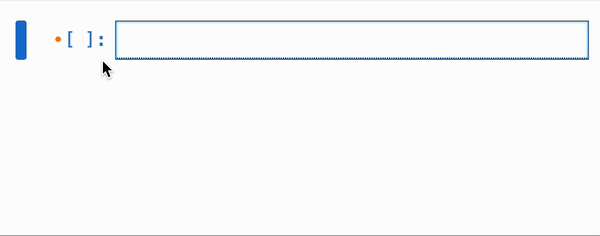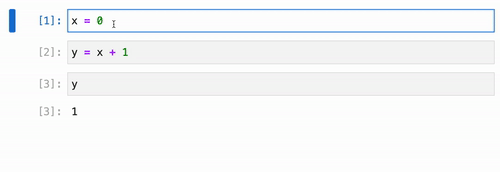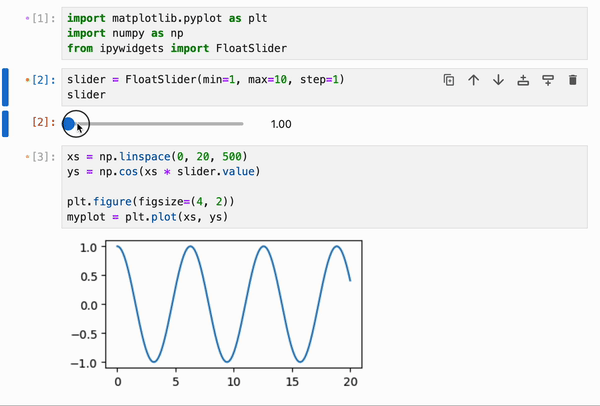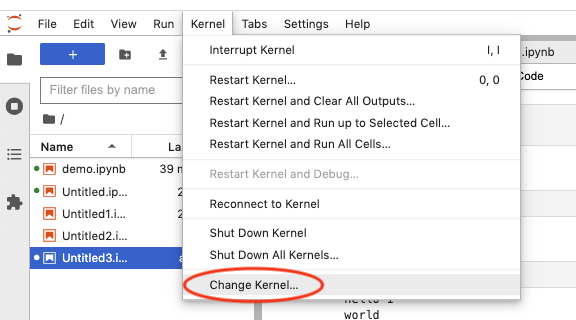A reactive Python kernel for Jupyter notebooks.
Project description
IPyflow
TL;DR
Reactive Python notebooks for Jupyter[Lab]:
pip install ipyflow- Pick
Python 3 (ipyflow)from the kernel dropdown. - Use
ctrl+shift+enter(orcmd+shift+enteron Mac) to execute a cell and everything that (recursively) depends on it:

About
IPyflow is a next-generation Python kernel for Jupyter and other notebook interfaces that tracks dataflow relationships between symbols and cells during a given interactive session, thereby making it easier to reason about notebook state. Here is a video of the JupyterCon talk introducing it (and corresponding slides).
If you'd like to skip the elevator pitch and skip straight to installation / activation instructions jump to quick start below; otherwise, keep reading to learn about IPyflow's features.
Features
IPyflow ships with classic Jupyter + JupyterLab extensions that provide the following user-facing features.
Execution Suggestions
IPyflow understands exactly what data changed in your notebook, when it changed, and when it got referenced. This allows it to provide execution suggestions whenever running some upstream cell changes data that downstream cells depend on. To keep the execution state consistent with the code in cells, rerun the turquoise-highlighted cells, and avoid the red-highlighted cells:

A turquoise-highlighted input with red-highlighted output just means that the output may be out-of-sync.
Reactivity
IPyflow enables opt-in reactive execution for both Jupyter and JupyterLab
(similar to Observable or
Pluto.jl, wherein execution of cell C
results in automatic re-execution of all of C's dependents). Use
ctrl+shift+enter (on Mac, cmd+shift+enter also works) to execute a cell and all of the cells that
(recursively) depend on it reactively:

You can also run the magic command %flow mode reactive in any cell to enable
reactivity as the default execution mode:

Disable by running %flow mode normal.
If you'd like to make reactivity the default behavior (not recommended, unless
you do not mind being surprised occasionally), you can add this to your IPython
profile (default location typically at
~/.ipython/profile_default/ipython_config.py):
c = get_config()
c.ipyflow.exec_mode = "reactive"
Syntax Extensions
Prefixing a symbol with $ in a load context will cause the referencing cell
to re-execute itself, whenever the aforementioned symbol is updated (regardless
of execution mode):

You can also use the $ syntax in store contexts, which triggers cells that
reference the corresponding symbol to re-execute, regardless of whether the
reference is similarly $-prefixed:

Finally, you can also prefix with $$ to trigger a cascading reactive update
to all dependencies in the chain, recursively:

Integration with ipywidgets
IPyflow's reactive execution engine, as well as its APIs (see "State API" below)
are fully compatible with ipywidgets, allowing cells to respond to slider changes,
button clicks, and other events:

This functionality can be paired with other extensions like stickyland to build fully reactive dashboards on top of JupyterLab + IPyflow.
State API
IPyflow must understand the underlying execution state at a deep level in
order to provide its features. It exposes an API for interacting with some of
this state, including a code function for obtaining the code necessary to
reconstruct some symbol:
# Cell 1
from ipyflow import code
# Cell 2
x = 0
# Cell 3
y = x + 1
# Cell 4
code(y)
# Output:
"""
# Cell 2
x = 0
# Cell 3
y = x + 1
"""
You can also see the cell (1-indexed) and statement (0-indexed) of when a
symbol was last updated with the timestamp function:
from ipyflow import timestamp
timestamp(y)
# Timestamp(cell_num=3, stmt_num=0)
To see dependencies and dependents of a particular symbol, use the deps and
users fuctions, respectively:
from ipyflow import deps, users
deps(y)
# [<x>]
users(x)
# [<y>]
If you want to elevate a symbol to the representation used internally by
IPyflow, use the lift function (at your own risk, of course):
from ipyflow import lift
y_sym = lift(y)
y_sym.timestamp
# Timestamp(cell_num=3, stmt_num=0)
Finally, IPyflow also comes with some rudimentary support for watchpoints:
# Cell 1
from ipyflow import watchpoints
def watchpoint(obj, position, symbol_name):
if obj <= 42:
return
cell, line = position
print(f"{symbol_name} = {obj} exceeds 42 at {cell=}, {line=}")
# Cell 2
y = 14
watchpoints(y).add(watchpoint)
# Cell 3
y += 10
# Cell 4
y += 20
# y = 44 exceeds 42 at cell=4, line=1
Quick Start
To install, run:
pip install ipyflow
To run an IPyflow kernel in JupyterLab, select "Python 3 (ipyflow)" from the list of available kernels in the Launcher tab. For classic Jupyter, similarly select "Python 3 (ipyflow)" from the list of notebook types in the "New" dropdown dialogue.
| JupyterLab Entrypoint: | Classic Jupyter Entrypoint: |
|---|---|
 |
 |
Similarly, you can switch to / from IPyflow from an existing notebook by navigating to the "Change kernel" file menu item in either JupyterLab or classic Jupyter:
| JupyterLab Kernel Switcher: | Classic Jupyter Kernel Switcher: |
|---|---|
 |
 |
Citing
IPyflow started its life under the name nbsafety, which provided the initial suggestions and slicing functionality.
For the execution suggestions:
@article{macke2021fine,
title={Fine-grained lineage for safer notebook interactions},
author={Macke, Stephen and Gong, Hongpu and Lee, Doris Jung-Lin and Head, Andrew and Xin, Doris and Parameswaran, Aditya},
journal={Proceedings of the VLDB Endowment},
volume={14},
number={6},
pages={1093--1101},
year={2021},
publisher={VLDB Endowment}
}
For the dynamic slicer (used for
reactivity and for the code function, for example):
@article{shankar2022bolt,
title={Bolt-on, Compact, and Rapid Program Slicing for Notebooks},
author={Shankar, Shreya and Macke, Stephen and Chasins, Andrew and Head, Andrew and Parameswaran, Aditya},
journal={Proceedings of the VLDB Endowment},
volume={15},
number={13},
pages={4038--4047},
year={2022},
publisher={VLDB Endowment}
}
We don't have a paper written yet for the syntax extensions that implement the reactive algebra, but in the mean time, you can cite the IPyflow repo directly for that and anything else not covered by the previous publications:
@misc{ipyflow,
title = {{IPyflow: A Next-Generation, Dataflow-Aware IPython Kernel}},
howpublished = {\url{https://github.com/ipyflow/ipyflow}},
year = {2022},
}
Acknowledgements
IPyflow would not have been possible without the amazing academic collaborators listed on the above papers. Its reactive execution features are inspired by those of other excellent tools like Hex notebooks, Pluto.jl, and Observable. This work has benefited from the support of folks from a number of companies -- both in the form of direct financial contributions (Databricks, Hex) as well as indirect moral support and encouragement (Ponder, Meta). And of course, IPyflow rests on the foundations built by the incredible Jupyter community.
License
Code in this project licensed under the BSD-3-Clause License.
Project details
Release history Release notifications | RSS feed
Download files
Download the file for your platform. If you're not sure which to choose, learn more about installing packages.
Source Distribution
Built Distribution
Hashes for ipyflow-0.0.182-py2.py3-none-any.whl
| Algorithm | Hash digest | |
|---|---|---|
| SHA256 | 42eafafcce6318a303f93c88cc15a2432398f5e0a5a0069474b9cab2760bca42 |
|
| MD5 | b5cef6dd4f79aef7fa0ca498cd4c1b46 |
|
| BLAKE2b-256 | a67856763dc61d284249e2f5df288940d91ed035185afb662e1207420f2d1e47 |


















